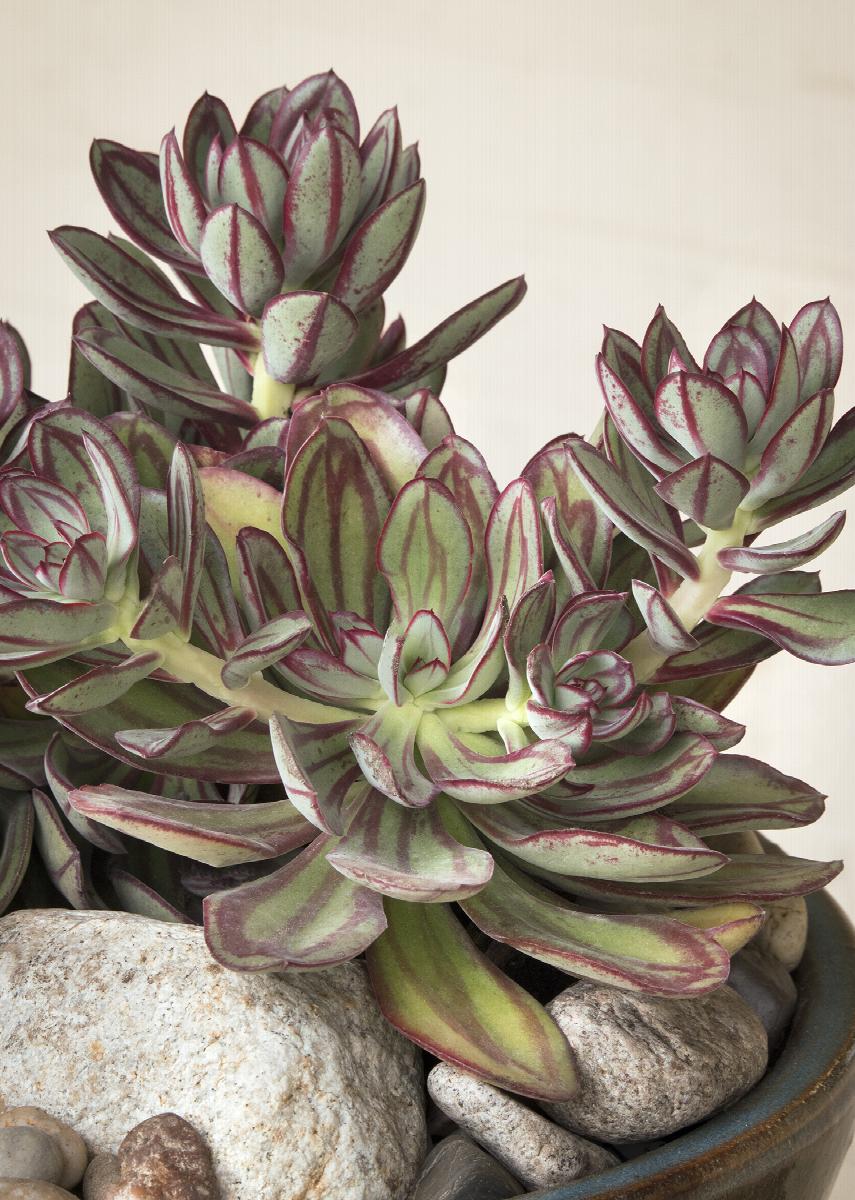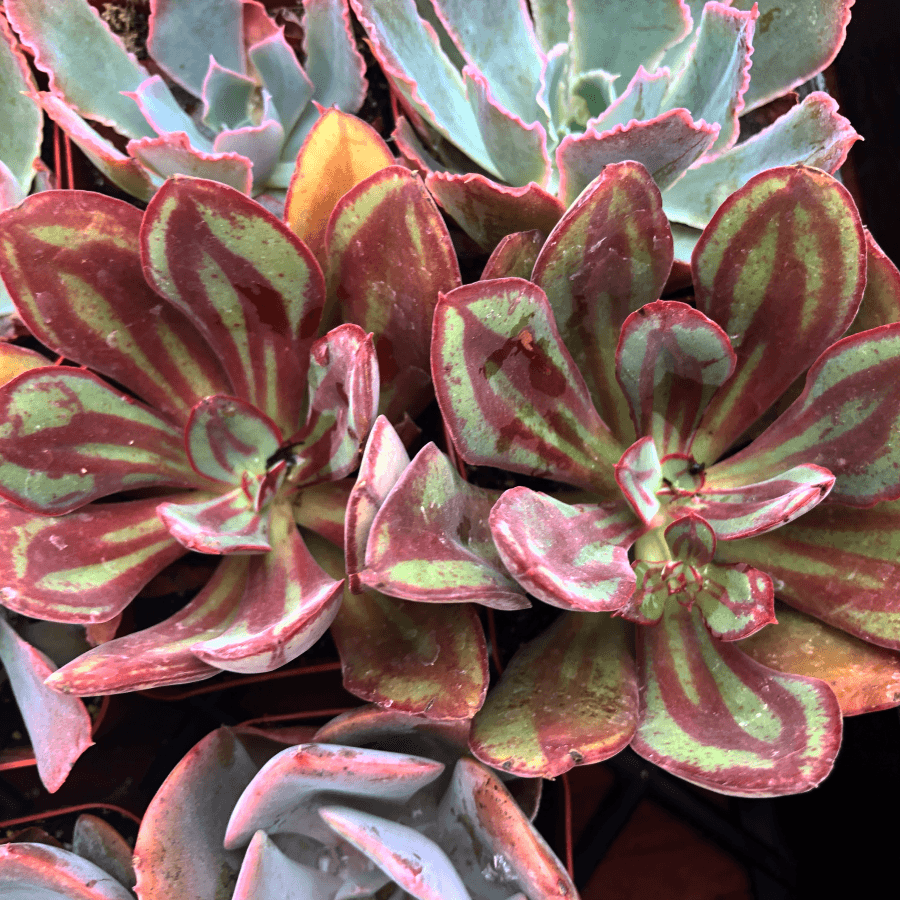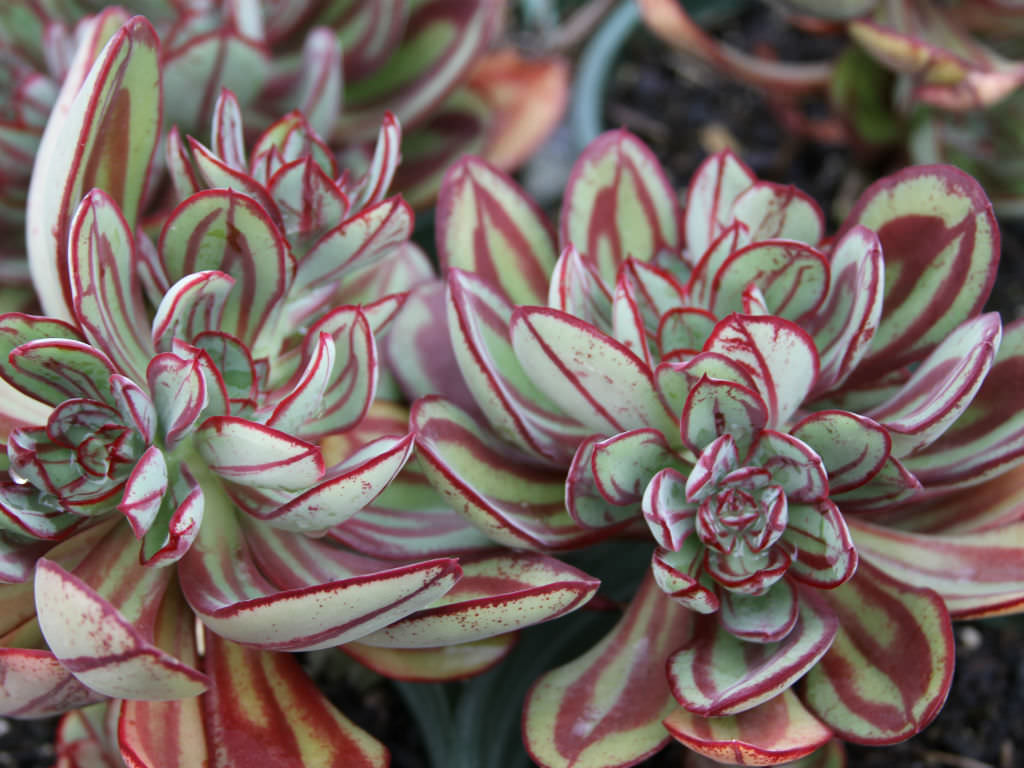This lime green succulent has red outlines around the leaves and stems that branch out, forming offspring that can be grown easily. Look out for pretty pink or yellow flowers in the summertime.
Table of Contents
Care and Propagation Information
Echeveria nodulosa “Painted Echeveria” can form mounds with a height of up to 2 feet (61 cm) and a width of 3 feet (.9 m). If you wish to keep the plant smaller, you can prune the branches and use the offsets for propagation.
Watering
“Painted Echeveria” should be watered using the “soak and dry” method, in which the soil is allowed to become completely dry before watering again. This is the typical watering technique for succulents.
Be certain to grab our complimentary watering cheat sheet to discover how to know when your succulents are receiving an excessive amount of water (and how to save them if necessary).
Where to Plant
This succulent, Echeveria nodulosa “Painted Echeveria”, is not tolerant of colder temperatures, so if you live in an area where the temperature drops below 30° F (-1.1° C), it’s best to keep it in a container that can be brought inside when necessary. This type of succulent prefers full to partial sun.
To ensure successful indoor planting, position the pot near a south-facing window (in the Northern Hemisphere) where it will get plenty of sunlight. If you notice the plant is becoming elongated, relocate it to a brighter spot or use a grow light to add additional light.
How to Propagate Echeveria nodulosa “Painted Echeveria”
You can reproduce Echeveria nodulosa “Painted Echeveria” by taking cuttings or by rooting leaves.
Cuttings
To propagate a “Painted Echeveria”, utilize a sharp, clean knife or scissors to make a cutting. Let the wound heal for a few days before planting in soil that has good drainage capability.
Leaves
To propagate “Painted Echeveria,” detach a leaf from the mother plant by twisting it off. Make sure the leaf is completely removed from the stem for optimal success.
Let the leaf sit undisturbed for several days until the cut end forms a callous, then place it in a pot with soil that drains well. Water the leaf only when the soil is completely dry.
Care and Propagation Information
General Care for Echeveria nodulosa “Painted Echeveria”
Watering
“Painted Echeveria” should be watered using the “soak and dry” method, in which the soil is allowed to become completely dry before watering again. This is the typical watering technique for succulents.
Be certain to grab our complimentary watering cheat sheet to discover how to know when your succulents are receiving an excessive amount of water (and how to save them if necessary).
Where to Plant
This succulent, Echeveria nodulosa “Painted Echeveria”, is not tolerant of colder temperatures, so if you live in an area where the temperature drops below 30° F (-1.1° C), it’s best to keep it in a container that can be brought inside when necessary. This type of succulent prefers full to partial sun.
To ensure successful indoor planting, position the pot near a south-facing window (in the Northern Hemisphere) where it will get plenty of sunlight. If you notice the plant is becoming elongated, relocate it to a brighter spot or use a grow light to add additional light.
How to Propagate Echeveria nodulosa “Painted Echeveria”
You can reproduce Echeveria nodulosa “Painted Echeveria” by taking cuttings or by rooting leaves.
Cuttings
To propagate a “Painted Echeveria”, utilize a sharp, clean knife or scissors to make a cutting. Let the wound heal for a few days before planting in soil that has good drainage capability.
Leaves
To propagate “Painted Echeveria,” detach a leaf from the mother plant by twisting it off. Make sure the leaf is completely removed from the stem for optimal success.
Let the leaf sit undisturbed for several days until the cut end forms a callous, then place it in a pot with soil that drains well. Water the leaf only when the soil is completely dry.
FAQ
What soil for Echeveria nodulosa?
What is the biggest Echeveria in the world?
Echeveria gibbiflora is the biggest of all echeveria species, and it is one of the main parent plants from which the majority of the large, cabbage-shaped echeveria hybrids were created.
Does Echeveria need sun or shade?
Paraphrase: Illumination: Planting succulents without enough light is a common mistake among gardeners. Make sure to place your echeveria near a window that gets at least six hours of direct sunlight a day. Without this light, your echeveria will become elongated and lose its appealing, dense shape.
What soil do Echeveria succulents like?
Echeverias are quite resilient and can survive in less than perfect conditions, but to ensure their optimal growth, they should be planted in well-drained soil with a south-facing exposure and a slightly acidic pH. Care should be taken to move the plants to a frost-free spot during the winter, as they cannot tolerate wet and cold temperatures.
What is the most beautiful Echeveria?
Echeveria perle von Nurnberg is a very well-known type of echeveria that is recognized by its single rosette of paddle-shaped, pale leaves. When it is kept in dim lighting, its leaves are greyish in color, though when it is exposed to full and direct sunlight, the leaves become a lovely pink and purple hue.



